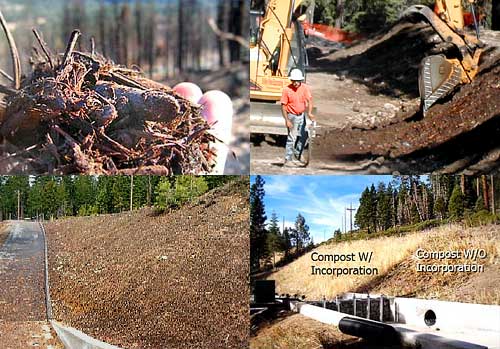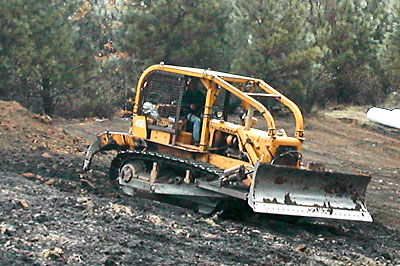Erosion Control Toolbox: Incorporate Materials
Introduction

Incorporate Materials involves tilling topsoil, duff, compost, straw and mulch into disturbed slope surfaces. Incorporating organic materials into the slope surface provides nutrients and biotic activity necessary to support sustainable growth of vegetation. The required depth of tilling or incorporation varies by slope gradient - steeper slopes are limited to a shallower depth of incorporation. Compost is typically mixed at a rate of 1 part compost to 3 parts soil, or 1/3 by volume. Rates of incorporation for other organic materials (straw, mulch, duff, etc.) vary.
When to Use This Treatment
- Use where disturbed site soils are compacted and/or low in nutrients. See the Application Rate Guidance for Compost section below.
- Consider these maximum incorporation depths:
- Slopes 3:1 (H:V) and steeper - 2"
- Slopes 4:1 (H:V) and flatter - 4"
- For 2:1 slopes, limit the use of Incorporate Materials to areas accessible by rototillers or tracked excavators
Benefits
- Reduced stormwater runoff volume and velocity
- Improved infiltration rate
- Improved soil water holding capacity
- Improved soil structure, porosity, and texture
- Improved plant rooting depth
- Improved soil chemical properties - provides proper pH, carbon, nitrogen, potassium and phosphorus levels
- Improved soil biology - activity by bacteria, mycorrhizal fungi, nematodes, protozoa, microarthropod and earthworms
- Improved soil nutrient levels and nutrient cycling
- Improved potential for vigorous long term vegetation coverage
Limitations
- May require temporary storage space within the project limits to stockpile materials
- Requires site accessibility by mechanized equipment
Design Considerations
- Verify availability for medium and coarse compost as these mixes may require a custom blend
- Determine if slopes require incorporation of organic material to support sustainable vegetation
Construction Tips
Depth of incorporation is constrained by slope angle and accessibility. Long, steep and inaccessible slopes are limited to smaller equipment. The photos below highlight the strengths and weaknesses of different types of equipment.

Rototilling (shown above) can be used to incorporate materials to depths less than 8 inches in flat areas. It is effective at mixing materials with topsoil, but has reduced benefits at depths greater than 6 inches.

Construction equipment (such as the bulldozer-attached chisel plow shown above) is effective at ripping and decompacting soil, yet ineffective at "incorporating" or "mixing" materials into topsoil. In short, ripping tines do not effectively mix amendments with soil.

A tractor drawn disk set (shown above) is a cost-effective method to incorporate materials for large flat areas. It is limited to depths of 6" to 12" and is not as effective as the tracked excavator shown below.

A tracked excavator with bucket attachment (shown above) can be used to incorporate materials on steeper slopes to depths up to 3 feet. It is much more effective than rototilling or ripping, however, equipment rental is more costly. A benefit to this approach is that the irregular nature of this mixing technique reduces the likelihood of creating a uniform "slip plane" between amended and non-amended soil layers, which may increase soil stability.
Consider Using WithTo provide protection for the soil surface, consider combining this treatment with:
Estimate Information
- Use Bid Item Code 210630 Incorporate Materials
Updated: January 25, 2019

